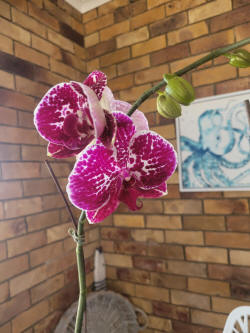
PHALAENOPSIS ORCHIDS
Plant descriptions Noel's Garden Vale Robert Percy History
Benefits of Growing Phalaenopsis Orchids
 |
| Phalaenopsis Orchid |
Phalaenopsis orchids are one of the most popular orchids to grow, and for good
reason. They are relatively easy to care for, they flower for a long time, and
they come in a wide variety of colours and shapes.
Here are some of the benefits of growing Phalaenopsis orchids:
·
They are easy to care for. Phalaenopsis orchids do not require a lot of sunlight
or water, making them a good choice for busy people or those who live in
apartments.
·
They flower for a long time. Phalaenopsis orchids can bloom for several months,
At the time of writing, September, I have had a Phalaenopsis that has been
flowering since May.
·
They come in a wide variety of colours and shapes. There are thousands of
different varieties of Phalaenopsis orchids, so you can find one that perfectly
suits your taste.
·
They are relatively inexpensive. Phalaenopsis orchids are not as expensive as
some other types of orchids, making them a more affordable option.
·
They can help improve air quality. Phalaenopsis orchids are known to help remove
pollutants from the air, making them a good choice for indoor air quality.
How to Encourage Flowering
To encourage flowering in Phalaenopsis orchids, you need to provide them with
the right conditions. Here are some tips:
 |
 |
| Five months and still flowering | Bright colours |
·
Give them bright, indirect sunlight.
·
Water them regularly, but allow the soil to dry out slightly between watering.
·
Fertilise them regularly during the growing season.
·
Keep the humidity high, around 70%.
·
Provide them with a cool night temperature (15-18°C) during the winter months.
Once the flowers on your Phalaenopsis orchid have faded, you can trim the flower
spike back to just above a node. A node is a small bump on the flower spike
where new leaves or flowers can grow. Trimming the flower spike back to a node
will encourage the orchid to produce a new flower spike. I usually prune to the
third node from the base.
To do this, use a sharp, sterilized pair of scissors or secateurs. Cut the
flower spike back to just above a node, making sure to cut at a sharp angle. Do
not cut the flower spike flush with the node, as this can damage the orchid.
You can also cut the flower spike back to the base of the plant, but this will
prevent the orchid from producing a new flower spike for that season.
Sterilize your scissors or shears before and after pruning to prevent the spread
of disease.

Dwarf Phalaenopsis Orchid
Climatic Conditions
Phalaenopsis orchids are native to tropical and subtropical climates, so they
prefer warm, humid conditions. The ideal temperature range for growing
Phalaenopsis orchids is between 20 and 27 degrees Celsius. The humidity should
be high, around 70%.
If you live in a sub tropical climate like south east Queensland Australia, you
can grow Phalaenopsis orchids outdoors in a sheltered spot. However, you will
need to protect them from frost and strong winds. You can also grow Phalaenopsis
orchids indoors, in a bright, sunny window.
Growing Media
Phalaenopsis orchids do not like to sit in wet soil, so it is important to use a
well-draining growing medium. A good option is to use a mix of orchid bark,
perlite, and charcoal. You can also use sphagnum moss, but this will need to be
kept moist.
Fertilisation and Care
 |
| Recently Aquired Varigated Form |
Phalaenopsis orchids need to be fertilised regularly, especially during the
growing season. You can use a balanced orchid fertiliser, or a fertiliser
specifically formulated for Phalaenopsis orchids. Fertilise your orchids every
2-4 weeks during the growing season. Other care tips for Phalaenopsis orchids
include:
·
Repot your orchids every 2-3 years, or when they outgrow their pot.
·
Watch out for pests and diseases, and treat them promptly if they occur.
·
Mist your orchids regularly to increase the humidity.
Pests and Diseases
Phalaenopsis orchids are relatively resistant to pests and diseases, but they
can be susceptible to mealy bugs, scale insects, and aphids. You can treat these
pests with insecticidal soap or neem oil. Phalaenopsis orchids can also be
susceptible to root rot, which is caused by overwatering. To prevent root rot,
make sure to water your orchids regularly, but allow the soil to dry out
slightly between watering.
Noel Percy
10/9/2023